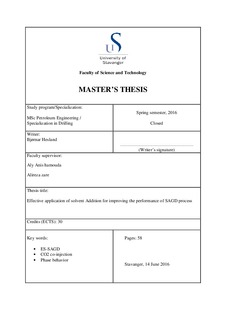Effective application of solvent addition for improving the performance of SAGD process
Master thesis
Permanent lenke
http://hdl.handle.net/11250/2408382Utgivelsesdato
2016-06Metadata
Vis full innførselSamlinger
Sammendrag
This research attempts to assess the effects of changing the injection times for CO2 solvent injection in the Solvent Assisted SAGD process and to study the phase behavior of Steam, Solvent and Oil.
Simulations were conducted using the Computer Modeling Group simulation software STARS 2014. The research evaluates the effect of injection start time, solvent concentration and solvent selection on performance criteria such as Energy efficiency, Cumulative oil production, and Solvent recovered from the reservoir. The phase behavior over two individual horizontal study lines was investigated to try and explain the difference in solvent performance. The injection performance of the four different hydrocarbon solvents was compared to the Steam-only SAGD process. The effect of co-injecting CO2 with hydrocarbon solvents was compared to the same solvents without the non-condensable gas.
Hexane was discovered to be the optimal solvent for energy efficiency and oil recovery at the cost of a suboptimal solvent recovery. The most optimal single-component concentration when considering the performance criteria lies in the range 20-30% by weight and an economic analysis would be needed to further narrow the range. The poor solvent recovery was remedied with Heptane which was shown to have an excellent solvent recovery and the two solvents were successfully co-injected. The proposed combination of solvents achieved better results than any single-component at the same concentration, which leads to the conclusion that there is a positive synergy between the two solvents. CO2 co-injection was tested with the previously investigated Hexane and Heptane solvents. It was found that there is a time period after starting hydrocarbon solvent injection where CO2 co-injection should not be initiated. There was however, a positive effect on the performance if the injection start time is delayed sufficiently.
The most interesting conclusion drawn from the research was the positive synergy between solvents when looking at multiple performance criteria in unison and the reported time period after starting hydrocarbon solvent injection where CO2 injection should not be initiated.
Beskrivelse
Master's thesis in Petroleum engineering
